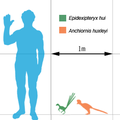Pennaraptora
Taxons de rang inférieur
Les Pennaraptora forment un clade d'animaux, créé par C. Foth en 2014, et défini comme le dernier ancêtre commun des dinosaures théropodes maniraptoriens Oviraptor philoceratops et Deinonychus antirrhopus, et du moineau domestique Passer domesticus, et de tous ses descendants[1].
Il regroupe le clade éteint des Oviraptorosauria et celui des Paraves qui inclut, entre autres, les oiseaux actuels.
Les plus anciens membres de ce clade sont de petits animaux, tous découverts en Chine, comme Epidexipteryx, Pedopenna, Anchiornis, Eosinopteryx et Xiaotingia, datent de l'Oxfordien (Jurassique supérieur)[2], il y a environ entre 160 Ma (millions d'années).
Étymologie
[modifier | modifier le code]Le nom du clade combine les mots latins « penna », « plume » et « raptor » « pillard » pour donner « pillard à plumes ».
Classification
[modifier | modifier le code]Avant l'érection des Pennaraptora, le clade des « Aviremigia » avait été proposé par Jacques Gauthier et Kevin de Queiroz en 2001 comme le groupe de panaviens avec un croupion rigide et avec des plumes pennées, des rectrices sur la queue et des rémiges sur les ailes (fermées par des barbules portant des pennules distales crochues)[3].
L'analyse phylogénétique simplifiée des groupes de théropodes, réalisée d'après C. Hendrickx et ses collègues en 2015[4] montre la position des Pennaraptora parmi les théropodes :
-
Vue d'artiste d'un des plus anciens Pennaraptora : Anchiornis.
-
Tailles comparée avec un humain de deux des plus anciens Pennaraptora Epidexipteryx (vert) et Anchiornis (orange).
-
Silhouette et squelette retrouvé d'Epidexipteryx hui.
-
Moulage du squelette d'un Pennaraptora oviraptoridé, Conchoraptor, placé sur un nid.
-
Vue d'artiste d'un Pennaraptora paravien, Serikornis par Emily Willoughby.
-
Un Pennaraptora actuel de la classe des oiseaux : le moineau domestique.
En 2017, la description de nouveaux genres comme le paravien basal Serikornis par Ulysse Lefèvre et ses collègues[5], le paravien Dromaeosauridae Halszkaraptor par Andrea Cau et ses collègues[6] et la redescription du spécimen d'Archaeopteryx de Haarlem reclassé comme un Avialae d'un nouveau genre (Ostromia) par C. Foth et Oliver Rauhut[2] a abouti à des cladogrammes sensiblement différents pour les Pennaraptora.
Le cladogramme ci-dessous est celui réalisé par Lefèvre et ses collègues[5], il est antérieur à la création de la famille des Anchiornithidae[2] :
| Pennaraptora |
| ||||||||||||||||||||||||||||||||||||||||||||||||||||||||||||||||||
Voir aussi
[modifier | modifier le code]Annexes
[modifier | modifier le code]Articles connexes
[modifier | modifier le code]Notes et références
[modifier | modifier le code]Références
[modifier | modifier le code]- (en) Christian Foth, « New specimen of Archaeopteryx provides insights into the evolution of pennaceous feathers », Nature, vol. 511, no 7507, , p. 79–82 (PMID 24990749, DOI 10.1038/nature13467)
- (en) C. Foth et O.W.M. Rauhut, « Re-evaluation of the Haarlem Archaeopteryx and the radiation of maniraptoran theropod dinosaurs », BMC Evolutionary Biology, vol. 17, , p. 236 (DOI 10.1186/s12862-017-1076-y, lire en ligne)
- (en) Gauthier, J. et de Queiroz, K. (2001). "Feathered dinosaurs, flying dinosaurs, crown dinosaurs, and the name 'Aves'". Pp. 7-41 in Gauthier, J. and L.F. Gall (eds.), New Perspectives on the Origin and Early Evolution of Birds: Proceedings of the International Symposium in Honor of John H. Ostrom. New Haven: Peabody Museum of Natural History, Yale University. (ISBN 0-912532-57-2)
- (en) C. Hendrickx, S.A. Hartman et O. Mateus, « An Overview of Non- Avian Theropod Discoveries and Classification », PalArch’s Journal of Vertebrate Palaeontology, vol. 12, no 1, , p. 1–73 (lire en ligne)
- (en) Ulysse Lefèvre, Andrea Cau, Aude Cincotta, Dongyu Hu, Anusuya Chinsamy, François Escuillié et Pascal Godefroit, « A new Jurassic theropod from China documents a transitional step in the macrostructure of feathers », The Science of Nature, vol. 104, no 74, (DOI 10.1007/s00114-017-1496-y, lire en ligne)
- (en) Andrea Cau, Vincent Beyrand, Dennis F. A. E. Voeten, Vincent Fernandez, Paul Tafforeau, Koen Stein, Rinchen Barsbold, Khishigjav Tsogtbaatar, Philip J. Currie et Pascal Godefroit, « Synchrotron scanning reveals amphibious ecomorphology in a new clade of bird-like dinosaurs », Nature, (DOI 10.1038/nature24679, lire en ligne)
Text is available under the CC BY-SA 4.0 license; additional terms may apply.
Images, videos and audio are available under their respective licenses.







